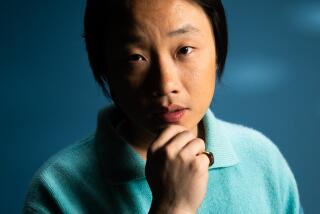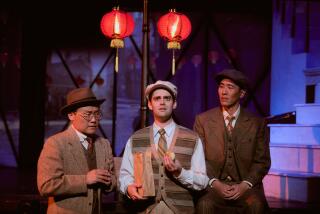Winds of Change That Come From the East
For those who are ready to write the year 2000 off as a terrible one for movies, here’s some advice: Don’t be too gloomy. Out of nowhere, Asian cinema has passionately emerged with a bounty of riches and delights, introducing us to different worlds, new sensations and fresh ways of telling stories.
At the same time, these diverse filmmakers grapple with issues of emotion and identity that are important and relevant to us all, and doing it with narrative complexity and stylistic daring. And the best part is, the Year of the Asian Film looks to continue well into 2001.
The most prominent of the films is, of course, “Crouching Tiger, Hidden Dragon,” which opened earlier this month to some of the best reviews of the year and best film honors from the Los Angeles Film Critics Assn. (the first time the group has given the award to a foreign-language film). In “Crouching Tiger,” Taiwanese director Ang Lee (“Sense and Sensibility”) merges the martial arts film with the art film to contrast two compelling love stories: one about middle-aged repression and regret, the other about youthful abandon and confusion.
The Chinese-language film got three Golden Globe nominations for director, original score (Tan Dun) and foreign-language film. It opened to record business in limited release and stands a good chance of breaking through to mainstream U.S. audiences and possibly even getting an Oscar nomination for best picture.
In the recently opened “Yi Yi” (A One and a Two), Taiwanese director Edward Yang weaves a lengthy and leisurely saga about contemporary Taipei, in which happiness and sadness are a fragile balancing act, and self-awareness and self-involvement are overcome through love and loss. The film won best foreign-language film honors from both the Los Angeles and New York critics’ groups. In “Suzhou River” (which has already come and gone), Chinese director Lou Ye takes us through a grim and grimy contemporary Shanghai, where love becomes an obsession and fate haunts those lonely romantics who believe the legends about their mysterious river.
“You can smell something different in the air,” Lee said in an interview. “It’s not fashionable and exotic. It’s a sign that [Asian] filmmakers are maturing, reaching middle age, a testament to the universality of filmmaking, a way of communicating.”
Next year promises more of the same. In “Chunhyang,” which opens in January, director Im Kwon Taek refashions Korea’s most enduring fable about love denied and reclaimed in the 18th century, incorporating an ancient oral narrative tradition that has long since been abandoned by his culture. In “In the Mood for Love,” which opens in February, director Wong Kar-wai revisits the 1962 Hong Kong of his youth to explore a timid love affair.
There’s something very pertinent about these five films; they are part of an extraordinary dialogue between the past and the present, in which traditions are uprooted, repression is overcome and female empowerment plays a vital role. In “Crouching Tiger,” the theft of an invincible sword sets off an emotional chain reaction: Chow Yun-Fat, a master warrior, seeks to fill an emotional void; Michelle Yeoh, his equal and soul mate, no longer keeps her emotional distance out of obligation; Zhang Ziyi, a reckless aristocratic girl with a hidden talent for martial arts, struggles to fulfill her promise; and Chang Chen, a bandit and Ziyi’s soul mate, tries to regain her love.
“The material allowed me to blend my realistic, cerebral approach with this operatic tradition,” says Lee. “We come from an emotionally repressed society and it gets blown out the other end through extreme physicality.”
This is exemplified in the film not only by the balletic display of fighting, but by the flying battles--or what Lee calls the “weightless leaping”--that express a powerful state of transcendence. “I’m reaching back to our oldest cultural roots, our oldest Chinese philosophy of becoming one with nature, blending the past with the future and trying something new,” Lee adds. “There is a hidden dragon in everyone, a secret part of us that we don’t understand but cannot escape.”
In “Yi Yi,” a multi-generational family is forced to confront its own hidden dragons, especially a father (Wu Nienjen) and his young son (Jonathan Chang), who are both repressed. The precocious lad complains to his father: “I can’t see what you see and you can’t see what I see. So how can I know what you see?”
So the boy takes pictures of the backs of people’s heads with his trusty camera, discovering that half a truth is better than none. For his part, the father comes out of his shell through a chance encounter with a spiritually enlightened artist and a reunion with his first love.
“Asians are taught to be conformist, and I’m showing how we can move away from that,” explains Yang, a native of Shanghai who moved to Taipei as a youngster. “There’s also too much hype, too much deception everywhere. The pleasant surprises in life are meeting someone who shares your secret beliefs and learning how to be courageous enough to ask questions, like the young boy.”
“In the Mood for Love” contains its own secret discoveries. The Hong Kong of 1962, as Wong remembers it, was filled with the sounds of Nat King Cole (singing Latin songs), Chinese opera and weather reports streaming from the radio. The city was courteous but claustrophobic, with the Cantonese living together with immigrants from mainland China.
Within this colorful and musical backdrop, two lonely neighbors, a journalist (Tony Leung Chiu-wai) and a secretary (Maggie Cheung) discover that their spouses may be having an affair, so each plays both victim and adulterer to get a handle on the situation, slowly falling in love in the process. And the atmosphere has its mesmerizing effect on the viewer as well. The ritual of the secretary walking a lonely street in a series of scenes, each time wearing a dazzling new dress but accompanied by the same seductive waltz, will not soon be forgotten.
“These are the romantic memories of a child,” Wong suggests. “‘It’s a simple story about people trying to find an identity in a new home. Back then, you could tell the difference between the two communities. Shanghai was more refined, more modern than Hong Kong. An environment like this creates rumors and stirs the imagination of children. It’s a time and place worth exploring.”
*
In “Suzhou River,” Lou pays homage to Alfred Hitchcock’s “Vertigo” with a Chinese ghost story about two men, a motorcycle messenger and a videographer, who discover that they may be in love with the same elusive woman (Zhou Xun, playing two roles) or cursed by a parallel twist of fate. We never see the videographer, who recounts the bizarre tale, which includes a fascination with mermaids and water. He is placed in the uncomfortable position of being both observer and participant.
“Our lives are influenced by so many cooked-up stories that we can hardly tell the difference between a fake story and true life,” Lou Ye explains. The Shanghai native, who refers to himself as one of the so-called “sixth generation” of Chinese directors--the new generation coming out of Chinese film studios--wishes to break free from the conventions of the past to find “a more complex mix of old and new.”
“I don’t believe in romance, while at the same time, I’m sure a romantic story will be of some help to people today,” he says. “I believe that when you’re extremely pessimistic, you might need a romantic story to pull you out--that is the human way.”
Speaking of romance, “Chunhyang” concerns the beautiful daughter (Lee Hyo Jung as Chunhyang) of a former courtesan who falls in love with the privileged son (Cho Seung Woo) of a governor. They are secretly married and then separated. When Chunhyang refuses the advances of the new governor, she is tortured, imprisoned and sentenced to death. Chunhyang’s undying love and devotion turn her into a heroic force for social change.
Im Kwon Taek, who has directed more than 90 Korean features, utilizes pansori, a wailing form of traditional narrative song, to help him tell this feudal folk tale. Singer Cho Sang Hyun gives an impassioned performance with falsetto and a guttural delivery.
“Pansori is the best form of traditional Korean art,” Im explains through a translator. “When I was a child, it was still popular. Everyone could still understand and enjoy it. But pansori has gotten lost since 1948. I’ve been wanting to make this version of ‘Chunhyang’ with pansori for a long time. I thought it would help evoke the warmth and brightness of this old fable. I finally found the courage.”
*
But how will these films fare with American audiences? Despite film festival honors and enthusiastic reviews, there is the pessimistic reminder that 2000 has seen a box office dip of 15% for art films. Yet “Crouching Tiger” and “In the Mood for Love” have a distinct advantage.
“It helps that Lee and Kar-wai have international appeal and Tony [Leung Chiu-wai] was picked as one of People magazine’s top 50 stars,” says Scott Greenstein, chairman of USA Films, the domestic distributor of “In the Mood for Love.” “It’s likely an American male audience will be drawn to the Lee film while women will be drawn to “In the Mood.’ ”
Industry observers note that it’s an opportune time for a new Asian cinema. The U.S. has a growing Asian population hungry for films that address their lives and concerns. The distributors of the films are also hopeful that films like “Crouching Tiger” and “In the Mood For Love” will have strong cross-over potential.
More to Read
Only good movies
Get the Indie Focus newsletter, Mark Olsen's weekly guide to the world of cinema.
You may occasionally receive promotional content from the Los Angeles Times.










